Knowledge of Management Theories: An Essay for Abacus Institute
VerifiedAdded on 2022/08/27
|23
|4920
|20
Essay
AI Summary
This essay provides a comprehensive overview of key aspects of organizational management, including organization theory, motivation theory, and leadership theory. The paper begins by examining major schools of management thought such as scientific management, human relations, and contingency approaches, along with organizational structures like functional and divisional models. It then delves into motivation, exploring content theories like Maslow's Hierarchy of Needs and Herzberg's Two-Factor Theory, as well as process theories such as equity and expectancy theories. The essay also discusses managerial approaches to motivation, job design, and the impact of social influences. Finally, it explores leadership, differentiating between leadership and management, analyzing various leadership styles, and evaluating their strengths and weaknesses. The essay concludes by synthesizing these concepts to highlight their contribution to effective organizational management. This essay is a great resource to understand the concepts of management and is available on Desklib, a platform providing students with past papers and solved assignments.
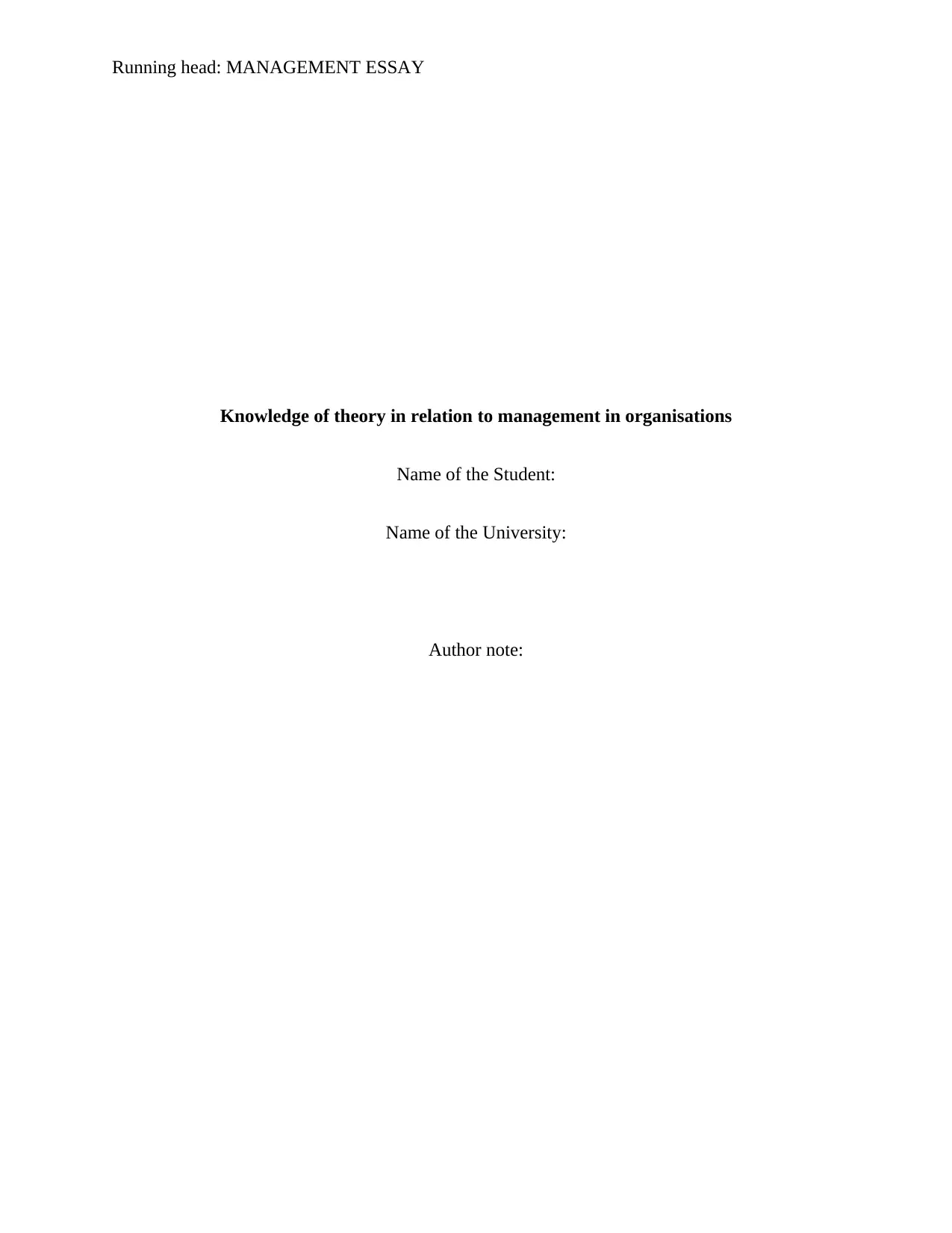
Running head: MANAGEMENT ESSAY
Knowledge of theory in relation to management in organisations
Name of the Student:
Name of the University:
Author note:
Knowledge of theory in relation to management in organisations
Name of the Student:
Name of the University:
Author note:
Paraphrase This Document
Need a fresh take? Get an instant paraphrase of this document with our AI Paraphraser
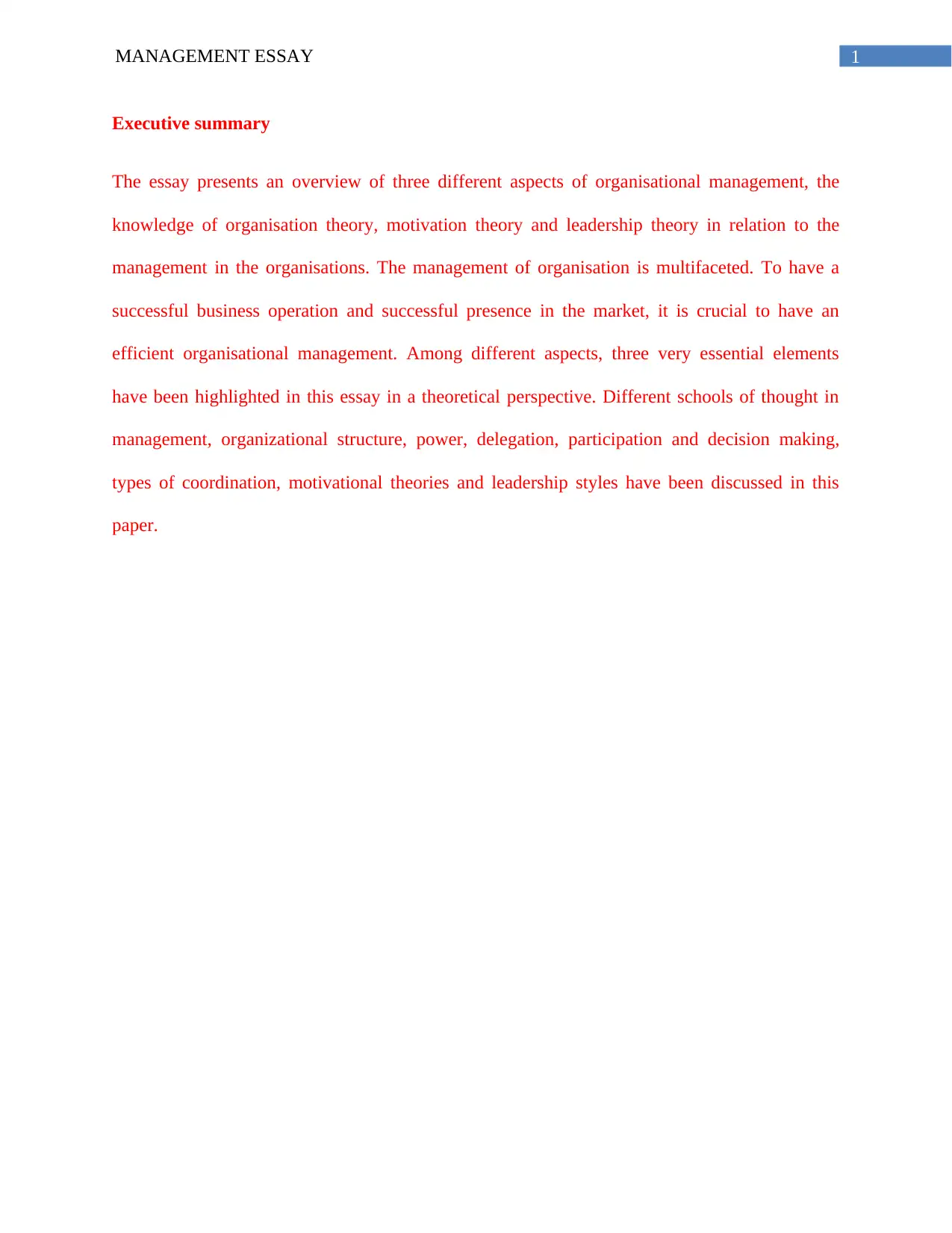
1MANAGEMENT ESSAY
Executive summary
The essay presents an overview of three different aspects of organisational management, the
knowledge of organisation theory, motivation theory and leadership theory in relation to the
management in the organisations. The management of organisation is multifaceted. To have a
successful business operation and successful presence in the market, it is crucial to have an
efficient organisational management. Among different aspects, three very essential elements
have been highlighted in this essay in a theoretical perspective. Different schools of thought in
management, organizational structure, power, delegation, participation and decision making,
types of coordination, motivational theories and leadership styles have been discussed in this
paper.
Executive summary
The essay presents an overview of three different aspects of organisational management, the
knowledge of organisation theory, motivation theory and leadership theory in relation to the
management in the organisations. The management of organisation is multifaceted. To have a
successful business operation and successful presence in the market, it is crucial to have an
efficient organisational management. Among different aspects, three very essential elements
have been highlighted in this essay in a theoretical perspective. Different schools of thought in
management, organizational structure, power, delegation, participation and decision making,
types of coordination, motivational theories and leadership styles have been discussed in this
paper.
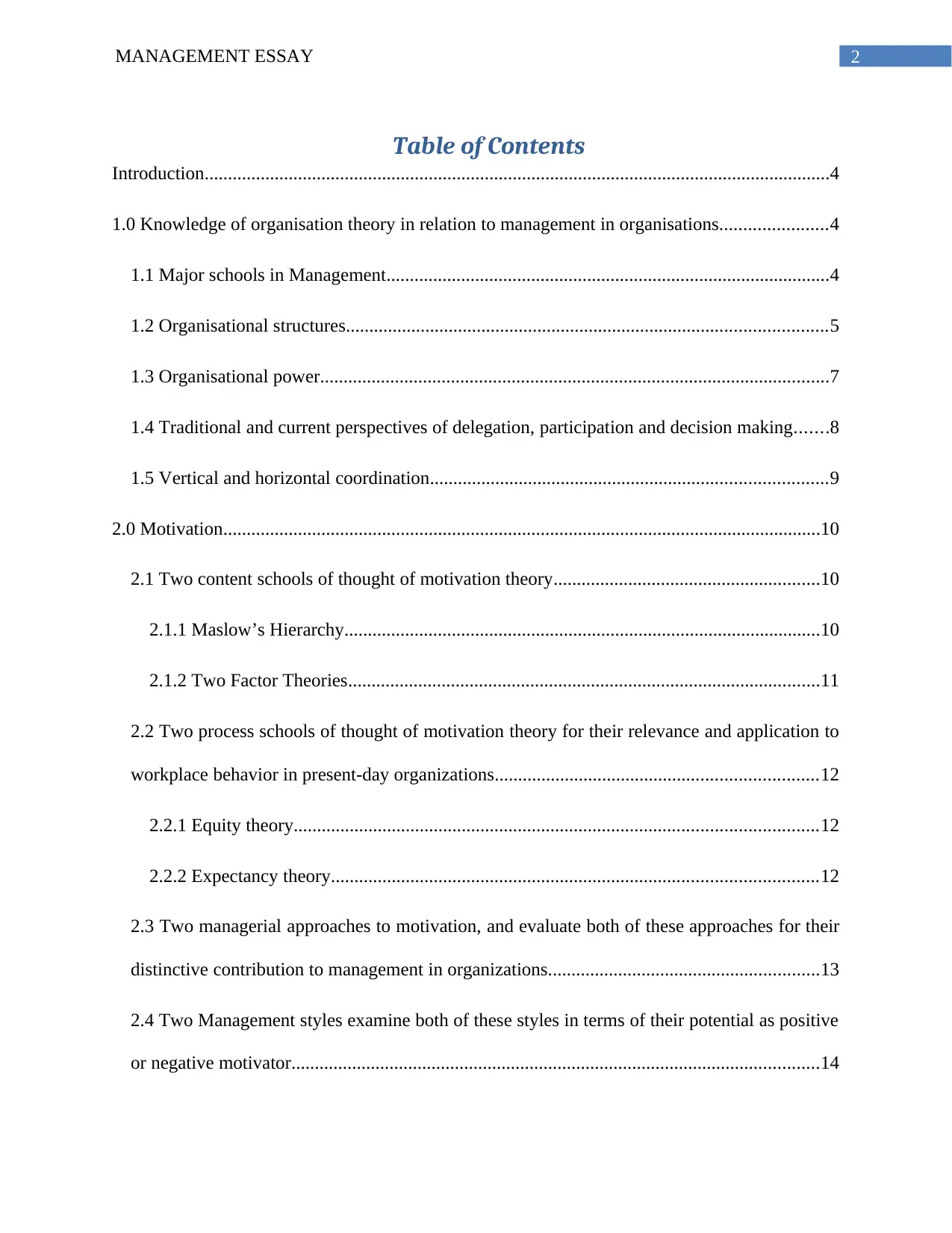
2MANAGEMENT ESSAY
Table of Contents
Introduction......................................................................................................................................4
1.0 Knowledge of organisation theory in relation to management in organisations.......................4
1.1 Major schools in Management...............................................................................................4
1.2 Organisational structures.......................................................................................................5
1.3 Organisational power.............................................................................................................7
1.4 Traditional and current perspectives of delegation, participation and decision making.......8
1.5 Vertical and horizontal coordination.....................................................................................9
2.0 Motivation................................................................................................................................10
2.1 Two content schools of thought of motivation theory.........................................................10
2.1.1 Maslow’s Hierarchy......................................................................................................10
2.1.2 Two Factor Theories.....................................................................................................11
2.2 Two process schools of thought of motivation theory for their relevance and application to
workplace behavior in present-day organizations.....................................................................12
2.2.1 Equity theory................................................................................................................12
2.2.2 Expectancy theory........................................................................................................12
2.3 Two managerial approaches to motivation, and evaluate both of these approaches for their
distinctive contribution to management in organizations..........................................................13
2.4 Two Management styles examine both of these styles in terms of their potential as positive
or negative motivator.................................................................................................................14
Table of Contents
Introduction......................................................................................................................................4
1.0 Knowledge of organisation theory in relation to management in organisations.......................4
1.1 Major schools in Management...............................................................................................4
1.2 Organisational structures.......................................................................................................5
1.3 Organisational power.............................................................................................................7
1.4 Traditional and current perspectives of delegation, participation and decision making.......8
1.5 Vertical and horizontal coordination.....................................................................................9
2.0 Motivation................................................................................................................................10
2.1 Two content schools of thought of motivation theory.........................................................10
2.1.1 Maslow’s Hierarchy......................................................................................................10
2.1.2 Two Factor Theories.....................................................................................................11
2.2 Two process schools of thought of motivation theory for their relevance and application to
workplace behavior in present-day organizations.....................................................................12
2.2.1 Equity theory................................................................................................................12
2.2.2 Expectancy theory........................................................................................................12
2.3 Two managerial approaches to motivation, and evaluate both of these approaches for their
distinctive contribution to management in organizations..........................................................13
2.4 Two Management styles examine both of these styles in terms of their potential as positive
or negative motivator.................................................................................................................14
⊘ This is a preview!⊘
Do you want full access?
Subscribe today to unlock all pages.

Trusted by 1+ million students worldwide
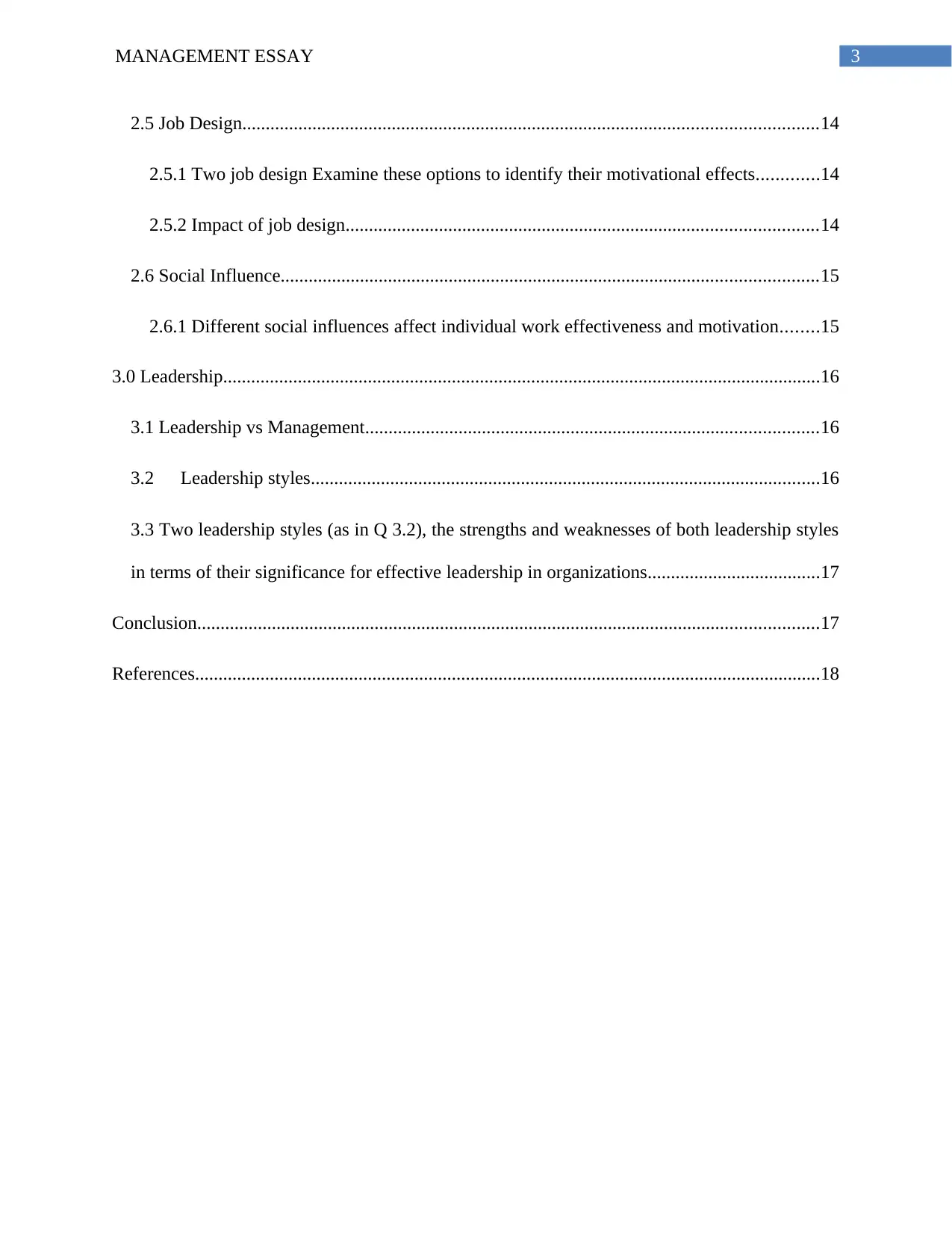
3MANAGEMENT ESSAY
2.5 Job Design...........................................................................................................................14
2.5.1 Two job design Examine these options to identify their motivational effects.............14
2.5.2 Impact of job design.....................................................................................................14
2.6 Social Influence...................................................................................................................15
2.6.1 Different social influences affect individual work effectiveness and motivation........15
3.0 Leadership................................................................................................................................16
3.1 Leadership vs Management.................................................................................................16
3.2 Leadership styles.............................................................................................................16
3.3 Two leadership styles (as in Q 3.2), the strengths and weaknesses of both leadership styles
in terms of their significance for effective leadership in organizations.....................................17
Conclusion.....................................................................................................................................17
References......................................................................................................................................18
2.5 Job Design...........................................................................................................................14
2.5.1 Two job design Examine these options to identify their motivational effects.............14
2.5.2 Impact of job design.....................................................................................................14
2.6 Social Influence...................................................................................................................15
2.6.1 Different social influences affect individual work effectiveness and motivation........15
3.0 Leadership................................................................................................................................16
3.1 Leadership vs Management.................................................................................................16
3.2 Leadership styles.............................................................................................................16
3.3 Two leadership styles (as in Q 3.2), the strengths and weaknesses of both leadership styles
in terms of their significance for effective leadership in organizations.....................................17
Conclusion.....................................................................................................................................17
References......................................................................................................................................18
Paraphrase This Document
Need a fresh take? Get an instant paraphrase of this document with our AI Paraphraser
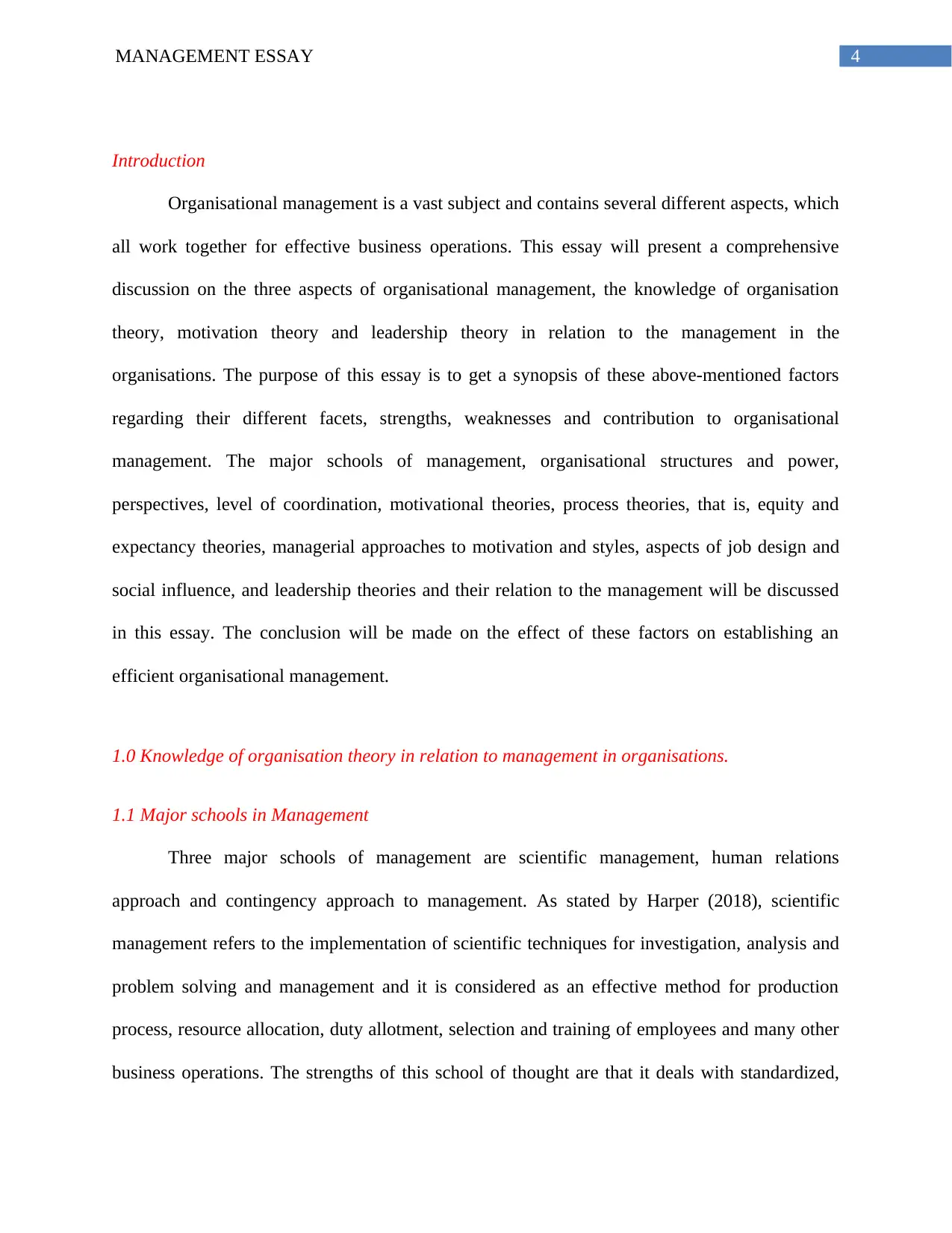
4MANAGEMENT ESSAY
Introduction
Organisational management is a vast subject and contains several different aspects, which
all work together for effective business operations. This essay will present a comprehensive
discussion on the three aspects of organisational management, the knowledge of organisation
theory, motivation theory and leadership theory in relation to the management in the
organisations. The purpose of this essay is to get a synopsis of these above-mentioned factors
regarding their different facets, strengths, weaknesses and contribution to organisational
management. The major schools of management, organisational structures and power,
perspectives, level of coordination, motivational theories, process theories, that is, equity and
expectancy theories, managerial approaches to motivation and styles, aspects of job design and
social influence, and leadership theories and their relation to the management will be discussed
in this essay. The conclusion will be made on the effect of these factors on establishing an
efficient organisational management.
1.0 Knowledge of organisation theory in relation to management in organisations.
1.1 Major schools in Management
Three major schools of management are scientific management, human relations
approach and contingency approach to management. As stated by Harper (2018), scientific
management refers to the implementation of scientific techniques for investigation, analysis and
problem solving and management and it is considered as an effective method for production
process, resource allocation, duty allotment, selection and training of employees and many other
business operations. The strengths of this school of thought are that it deals with standardized,
Introduction
Organisational management is a vast subject and contains several different aspects, which
all work together for effective business operations. This essay will present a comprehensive
discussion on the three aspects of organisational management, the knowledge of organisation
theory, motivation theory and leadership theory in relation to the management in the
organisations. The purpose of this essay is to get a synopsis of these above-mentioned factors
regarding their different facets, strengths, weaknesses and contribution to organisational
management. The major schools of management, organisational structures and power,
perspectives, level of coordination, motivational theories, process theories, that is, equity and
expectancy theories, managerial approaches to motivation and styles, aspects of job design and
social influence, and leadership theories and their relation to the management will be discussed
in this essay. The conclusion will be made on the effect of these factors on establishing an
efficient organisational management.
1.0 Knowledge of organisation theory in relation to management in organisations.
1.1 Major schools in Management
Three major schools of management are scientific management, human relations
approach and contingency approach to management. As stated by Harper (2018), scientific
management refers to the implementation of scientific techniques for investigation, analysis and
problem solving and management and it is considered as an effective method for production
process, resource allocation, duty allotment, selection and training of employees and many other
business operations. The strengths of this school of thought are that it deals with standardized,
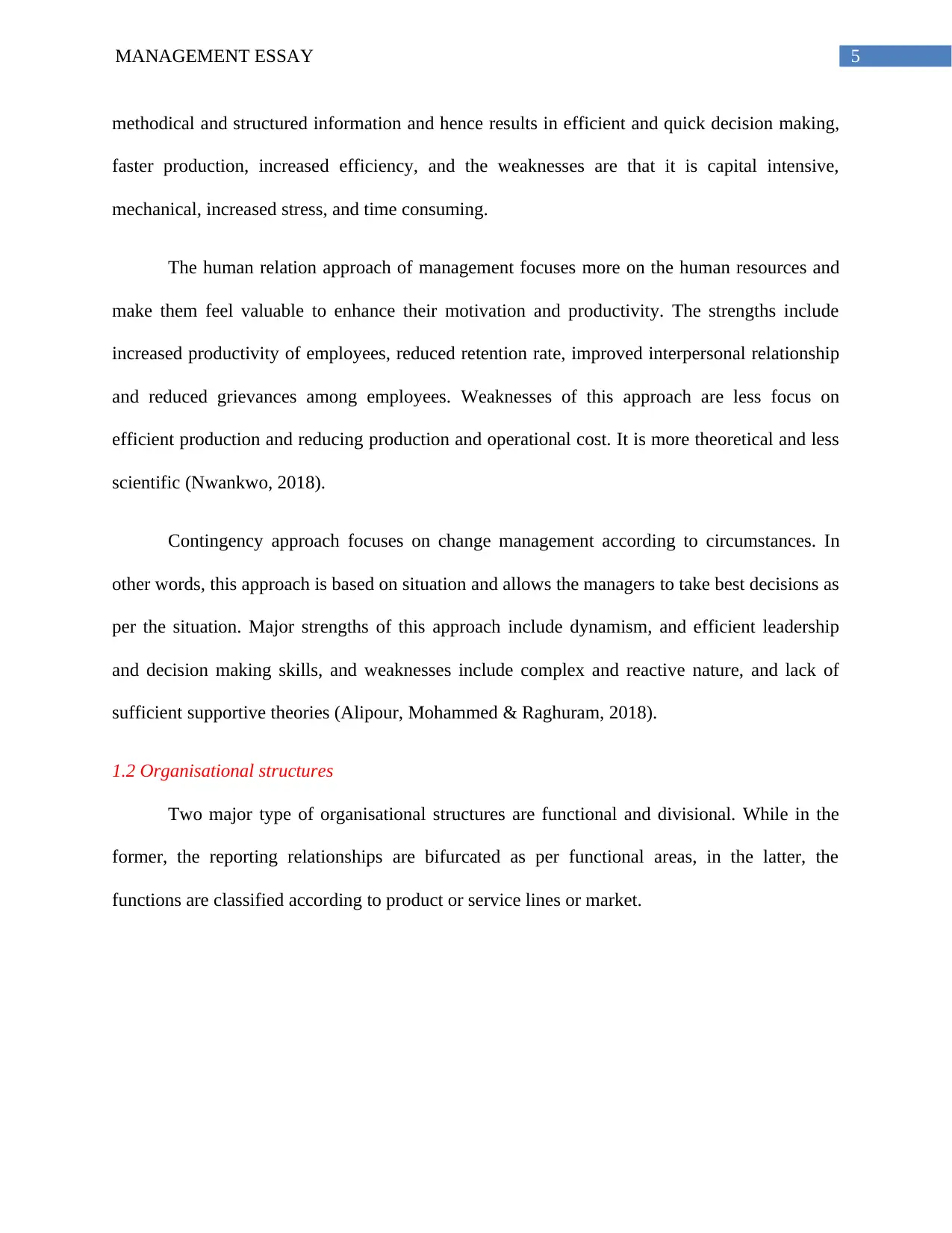
5MANAGEMENT ESSAY
methodical and structured information and hence results in efficient and quick decision making,
faster production, increased efficiency, and the weaknesses are that it is capital intensive,
mechanical, increased stress, and time consuming.
The human relation approach of management focuses more on the human resources and
make them feel valuable to enhance their motivation and productivity. The strengths include
increased productivity of employees, reduced retention rate, improved interpersonal relationship
and reduced grievances among employees. Weaknesses of this approach are less focus on
efficient production and reducing production and operational cost. It is more theoretical and less
scientific (Nwankwo, 2018).
Contingency approach focuses on change management according to circumstances. In
other words, this approach is based on situation and allows the managers to take best decisions as
per the situation. Major strengths of this approach include dynamism, and efficient leadership
and decision making skills, and weaknesses include complex and reactive nature, and lack of
sufficient supportive theories (Alipour, Mohammed & Raghuram, 2018).
1.2 Organisational structures
Two major type of organisational structures are functional and divisional. While in the
former, the reporting relationships are bifurcated as per functional areas, in the latter, the
functions are classified according to product or service lines or market.
methodical and structured information and hence results in efficient and quick decision making,
faster production, increased efficiency, and the weaknesses are that it is capital intensive,
mechanical, increased stress, and time consuming.
The human relation approach of management focuses more on the human resources and
make them feel valuable to enhance their motivation and productivity. The strengths include
increased productivity of employees, reduced retention rate, improved interpersonal relationship
and reduced grievances among employees. Weaknesses of this approach are less focus on
efficient production and reducing production and operational cost. It is more theoretical and less
scientific (Nwankwo, 2018).
Contingency approach focuses on change management according to circumstances. In
other words, this approach is based on situation and allows the managers to take best decisions as
per the situation. Major strengths of this approach include dynamism, and efficient leadership
and decision making skills, and weaknesses include complex and reactive nature, and lack of
sufficient supportive theories (Alipour, Mohammed & Raghuram, 2018).
1.2 Organisational structures
Two major type of organisational structures are functional and divisional. While in the
former, the reporting relationships are bifurcated as per functional areas, in the latter, the
functions are classified according to product or service lines or market.
⊘ This is a preview!⊘
Do you want full access?
Subscribe today to unlock all pages.

Trusted by 1+ million students worldwide
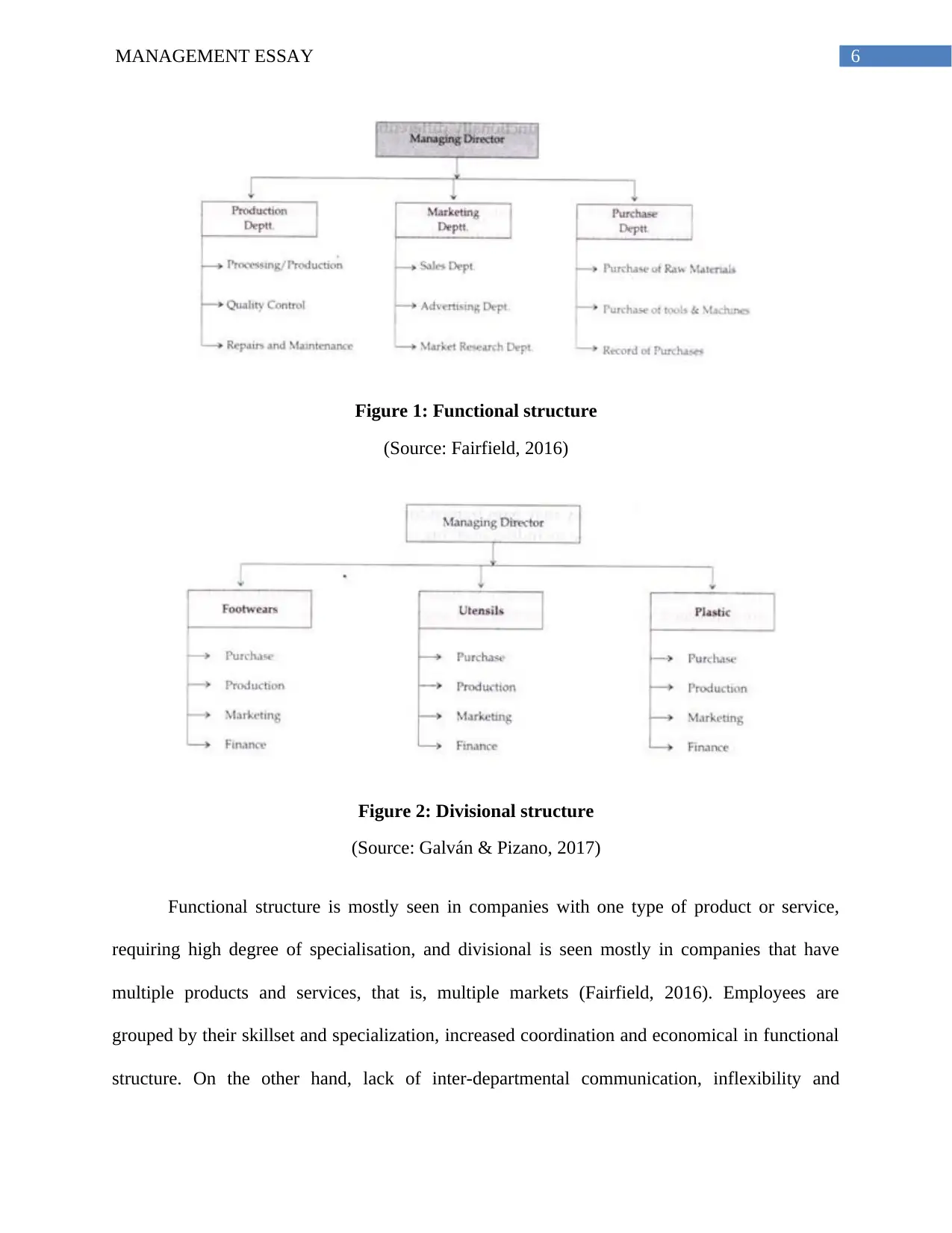
6MANAGEMENT ESSAY
Figure 1: Functional structure
(Source: Fairfield, 2016)
Figure 2: Divisional structure
(Source: Galván & Pizano, 2017)
Functional structure is mostly seen in companies with one type of product or service,
requiring high degree of specialisation, and divisional is seen mostly in companies that have
multiple products and services, that is, multiple markets (Fairfield, 2016). Employees are
grouped by their skillset and specialization, increased coordination and economical in functional
structure. On the other hand, lack of inter-departmental communication, inflexibility and
Figure 1: Functional structure
(Source: Fairfield, 2016)
Figure 2: Divisional structure
(Source: Galván & Pizano, 2017)
Functional structure is mostly seen in companies with one type of product or service,
requiring high degree of specialisation, and divisional is seen mostly in companies that have
multiple products and services, that is, multiple markets (Fairfield, 2016). Employees are
grouped by their skillset and specialization, increased coordination and economical in functional
structure. On the other hand, lack of inter-departmental communication, inflexibility and
Paraphrase This Document
Need a fresh take? Get an instant paraphrase of this document with our AI Paraphraser
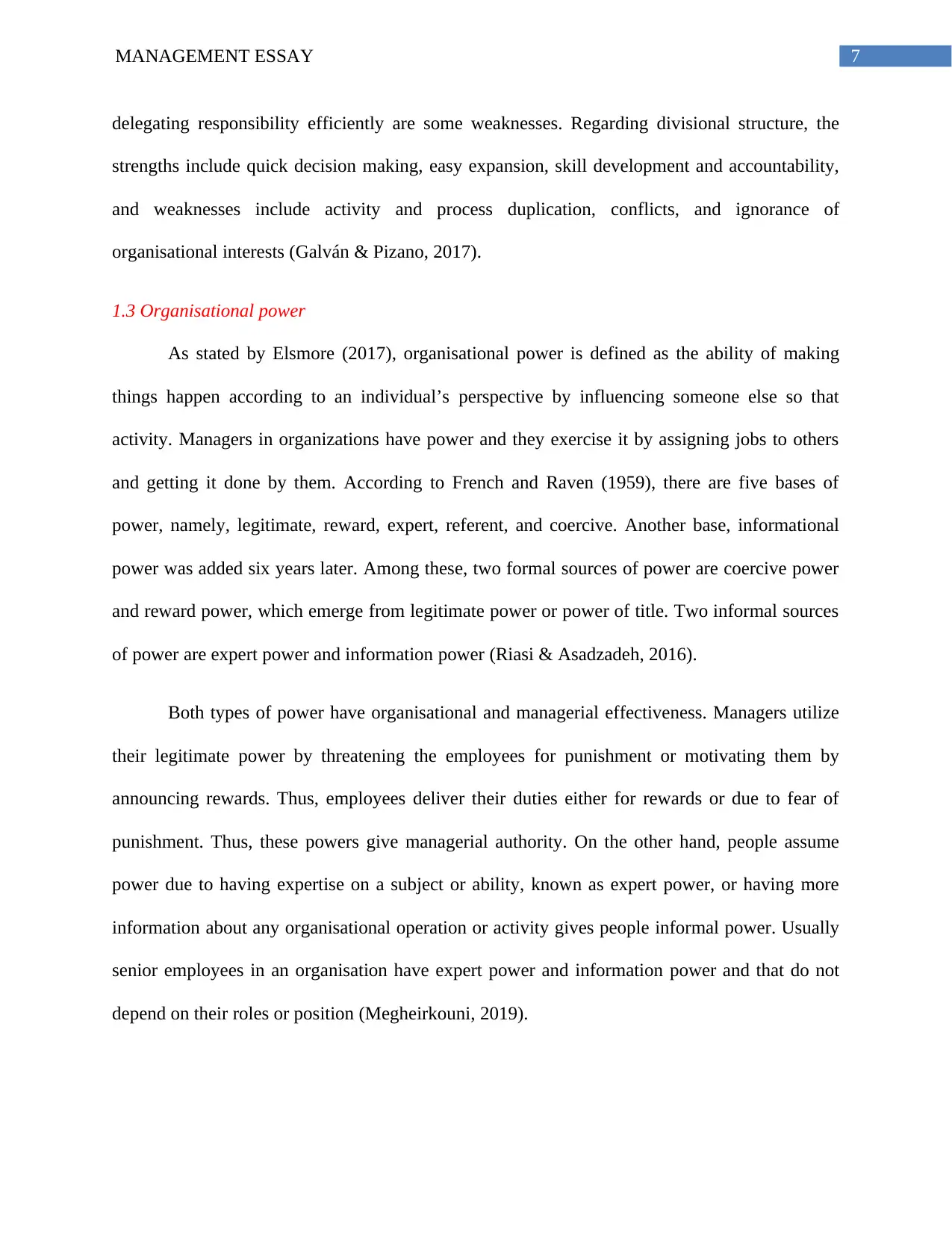
7MANAGEMENT ESSAY
delegating responsibility efficiently are some weaknesses. Regarding divisional structure, the
strengths include quick decision making, easy expansion, skill development and accountability,
and weaknesses include activity and process duplication, conflicts, and ignorance of
organisational interests (Galván & Pizano, 2017).
1.3 Organisational power
As stated by Elsmore (2017), organisational power is defined as the ability of making
things happen according to an individual’s perspective by influencing someone else so that
activity. Managers in organizations have power and they exercise it by assigning jobs to others
and getting it done by them. According to French and Raven (1959), there are five bases of
power, namely, legitimate, reward, expert, referent, and coercive. Another base, informational
power was added six years later. Among these, two formal sources of power are coercive power
and reward power, which emerge from legitimate power or power of title. Two informal sources
of power are expert power and information power (Riasi & Asadzadeh, 2016).
Both types of power have organisational and managerial effectiveness. Managers utilize
their legitimate power by threatening the employees for punishment or motivating them by
announcing rewards. Thus, employees deliver their duties either for rewards or due to fear of
punishment. Thus, these powers give managerial authority. On the other hand, people assume
power due to having expertise on a subject or ability, known as expert power, or having more
information about any organisational operation or activity gives people informal power. Usually
senior employees in an organisation have expert power and information power and that do not
depend on their roles or position (Megheirkouni, 2019).
delegating responsibility efficiently are some weaknesses. Regarding divisional structure, the
strengths include quick decision making, easy expansion, skill development and accountability,
and weaknesses include activity and process duplication, conflicts, and ignorance of
organisational interests (Galván & Pizano, 2017).
1.3 Organisational power
As stated by Elsmore (2017), organisational power is defined as the ability of making
things happen according to an individual’s perspective by influencing someone else so that
activity. Managers in organizations have power and they exercise it by assigning jobs to others
and getting it done by them. According to French and Raven (1959), there are five bases of
power, namely, legitimate, reward, expert, referent, and coercive. Another base, informational
power was added six years later. Among these, two formal sources of power are coercive power
and reward power, which emerge from legitimate power or power of title. Two informal sources
of power are expert power and information power (Riasi & Asadzadeh, 2016).
Both types of power have organisational and managerial effectiveness. Managers utilize
their legitimate power by threatening the employees for punishment or motivating them by
announcing rewards. Thus, employees deliver their duties either for rewards or due to fear of
punishment. Thus, these powers give managerial authority. On the other hand, people assume
power due to having expertise on a subject or ability, known as expert power, or having more
information about any organisational operation or activity gives people informal power. Usually
senior employees in an organisation have expert power and information power and that do not
depend on their roles or position (Megheirkouni, 2019).
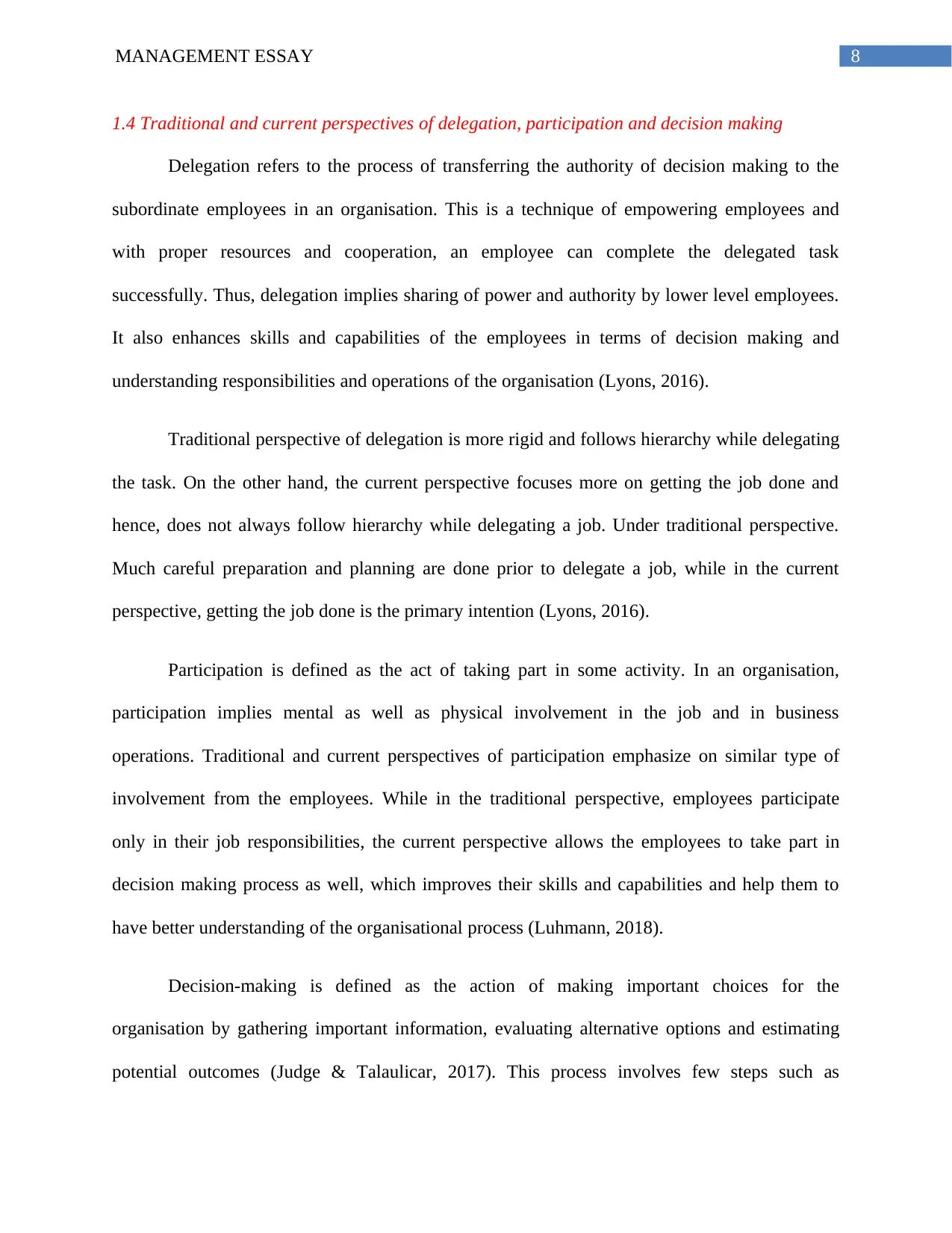
8MANAGEMENT ESSAY
1.4 Traditional and current perspectives of delegation, participation and decision making
Delegation refers to the process of transferring the authority of decision making to the
subordinate employees in an organisation. This is a technique of empowering employees and
with proper resources and cooperation, an employee can complete the delegated task
successfully. Thus, delegation implies sharing of power and authority by lower level employees.
It also enhances skills and capabilities of the employees in terms of decision making and
understanding responsibilities and operations of the organisation (Lyons, 2016).
Traditional perspective of delegation is more rigid and follows hierarchy while delegating
the task. On the other hand, the current perspective focuses more on getting the job done and
hence, does not always follow hierarchy while delegating a job. Under traditional perspective.
Much careful preparation and planning are done prior to delegate a job, while in the current
perspective, getting the job done is the primary intention (Lyons, 2016).
Participation is defined as the act of taking part in some activity. In an organisation,
participation implies mental as well as physical involvement in the job and in business
operations. Traditional and current perspectives of participation emphasize on similar type of
involvement from the employees. While in the traditional perspective, employees participate
only in their job responsibilities, the current perspective allows the employees to take part in
decision making process as well, which improves their skills and capabilities and help them to
have better understanding of the organisational process (Luhmann, 2018).
Decision-making is defined as the action of making important choices for the
organisation by gathering important information, evaluating alternative options and estimating
potential outcomes (Judge & Talaulicar, 2017). This process involves few steps such as
1.4 Traditional and current perspectives of delegation, participation and decision making
Delegation refers to the process of transferring the authority of decision making to the
subordinate employees in an organisation. This is a technique of empowering employees and
with proper resources and cooperation, an employee can complete the delegated task
successfully. Thus, delegation implies sharing of power and authority by lower level employees.
It also enhances skills and capabilities of the employees in terms of decision making and
understanding responsibilities and operations of the organisation (Lyons, 2016).
Traditional perspective of delegation is more rigid and follows hierarchy while delegating
the task. On the other hand, the current perspective focuses more on getting the job done and
hence, does not always follow hierarchy while delegating a job. Under traditional perspective.
Much careful preparation and planning are done prior to delegate a job, while in the current
perspective, getting the job done is the primary intention (Lyons, 2016).
Participation is defined as the act of taking part in some activity. In an organisation,
participation implies mental as well as physical involvement in the job and in business
operations. Traditional and current perspectives of participation emphasize on similar type of
involvement from the employees. While in the traditional perspective, employees participate
only in their job responsibilities, the current perspective allows the employees to take part in
decision making process as well, which improves their skills and capabilities and help them to
have better understanding of the organisational process (Luhmann, 2018).
Decision-making is defined as the action of making important choices for the
organisation by gathering important information, evaluating alternative options and estimating
potential outcomes (Judge & Talaulicar, 2017). This process involves few steps such as
⊘ This is a preview!⊘
Do you want full access?
Subscribe today to unlock all pages.

Trusted by 1+ million students worldwide
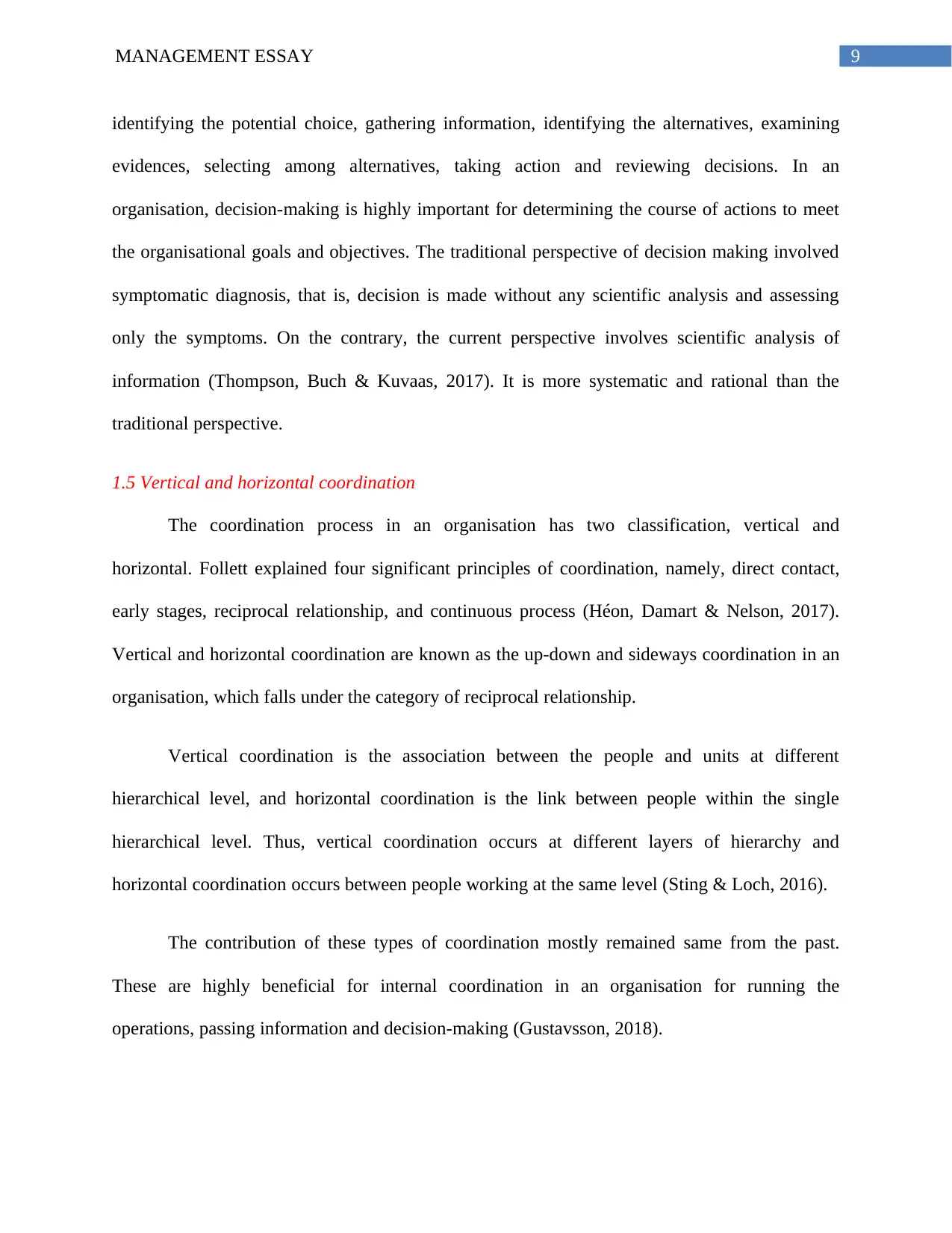
9MANAGEMENT ESSAY
identifying the potential choice, gathering information, identifying the alternatives, examining
evidences, selecting among alternatives, taking action and reviewing decisions. In an
organisation, decision-making is highly important for determining the course of actions to meet
the organisational goals and objectives. The traditional perspective of decision making involved
symptomatic diagnosis, that is, decision is made without any scientific analysis and assessing
only the symptoms. On the contrary, the current perspective involves scientific analysis of
information (Thompson, Buch & Kuvaas, 2017). It is more systematic and rational than the
traditional perspective.
1.5 Vertical and horizontal coordination
The coordination process in an organisation has two classification, vertical and
horizontal. Follett explained four significant principles of coordination, namely, direct contact,
early stages, reciprocal relationship, and continuous process (Héon, Damart & Nelson, 2017).
Vertical and horizontal coordination are known as the up-down and sideways coordination in an
organisation, which falls under the category of reciprocal relationship.
Vertical coordination is the association between the people and units at different
hierarchical level, and horizontal coordination is the link between people within the single
hierarchical level. Thus, vertical coordination occurs at different layers of hierarchy and
horizontal coordination occurs between people working at the same level (Sting & Loch, 2016).
The contribution of these types of coordination mostly remained same from the past.
These are highly beneficial for internal coordination in an organisation for running the
operations, passing information and decision-making (Gustavsson, 2018).
identifying the potential choice, gathering information, identifying the alternatives, examining
evidences, selecting among alternatives, taking action and reviewing decisions. In an
organisation, decision-making is highly important for determining the course of actions to meet
the organisational goals and objectives. The traditional perspective of decision making involved
symptomatic diagnosis, that is, decision is made without any scientific analysis and assessing
only the symptoms. On the contrary, the current perspective involves scientific analysis of
information (Thompson, Buch & Kuvaas, 2017). It is more systematic and rational than the
traditional perspective.
1.5 Vertical and horizontal coordination
The coordination process in an organisation has two classification, vertical and
horizontal. Follett explained four significant principles of coordination, namely, direct contact,
early stages, reciprocal relationship, and continuous process (Héon, Damart & Nelson, 2017).
Vertical and horizontal coordination are known as the up-down and sideways coordination in an
organisation, which falls under the category of reciprocal relationship.
Vertical coordination is the association between the people and units at different
hierarchical level, and horizontal coordination is the link between people within the single
hierarchical level. Thus, vertical coordination occurs at different layers of hierarchy and
horizontal coordination occurs between people working at the same level (Sting & Loch, 2016).
The contribution of these types of coordination mostly remained same from the past.
These are highly beneficial for internal coordination in an organisation for running the
operations, passing information and decision-making (Gustavsson, 2018).
Paraphrase This Document
Need a fresh take? Get an instant paraphrase of this document with our AI Paraphraser
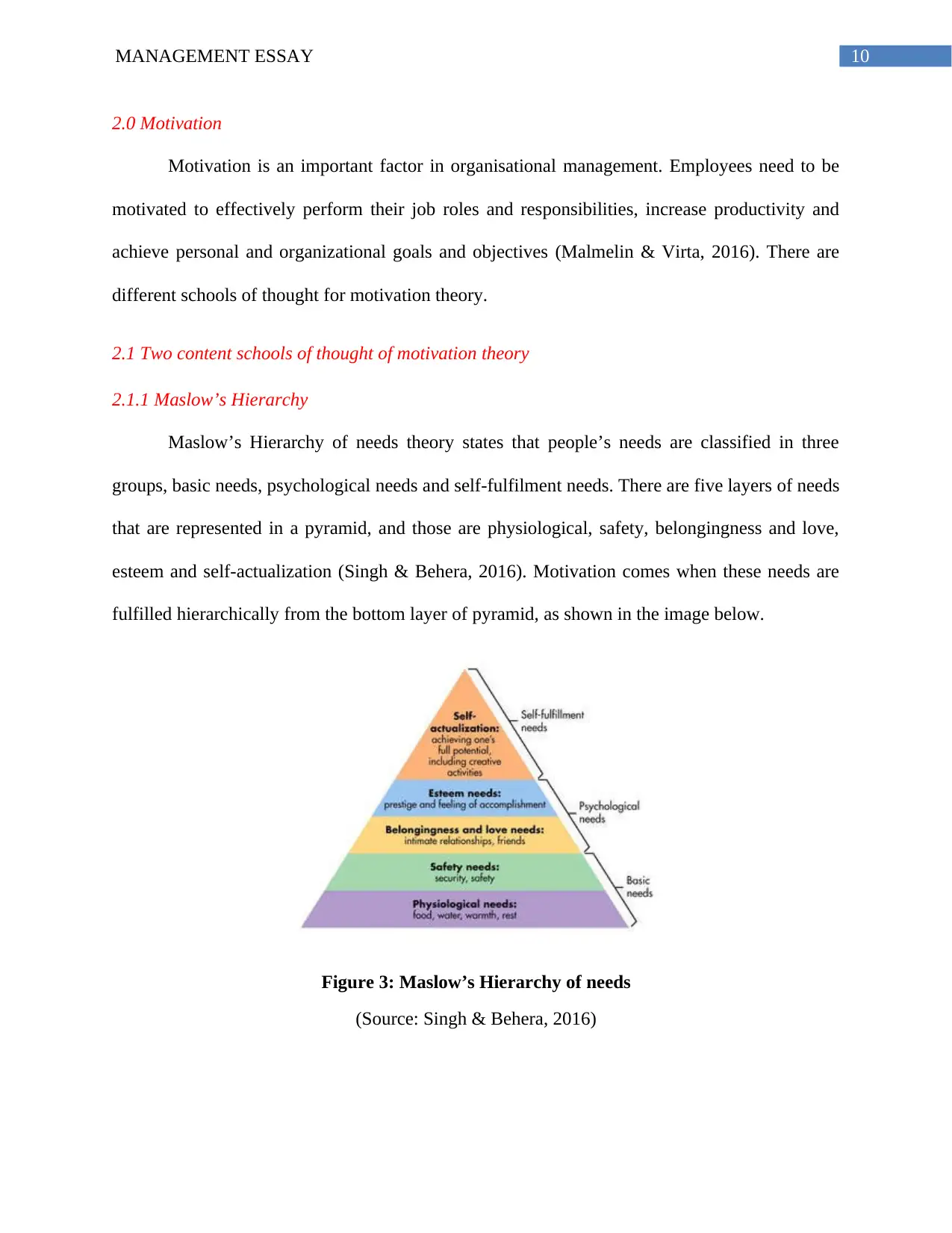
10MANAGEMENT ESSAY
2.0 Motivation
Motivation is an important factor in organisational management. Employees need to be
motivated to effectively perform their job roles and responsibilities, increase productivity and
achieve personal and organizational goals and objectives (Malmelin & Virta, 2016). There are
different schools of thought for motivation theory.
2.1 Two content schools of thought of motivation theory
2.1.1 Maslow’s Hierarchy
Maslow’s Hierarchy of needs theory states that people’s needs are classified in three
groups, basic needs, psychological needs and self-fulfilment needs. There are five layers of needs
that are represented in a pyramid, and those are physiological, safety, belongingness and love,
esteem and self-actualization (Singh & Behera, 2016). Motivation comes when these needs are
fulfilled hierarchically from the bottom layer of pyramid, as shown in the image below.
Figure 3: Maslow’s Hierarchy of needs
(Source: Singh & Behera, 2016)
2.0 Motivation
Motivation is an important factor in organisational management. Employees need to be
motivated to effectively perform their job roles and responsibilities, increase productivity and
achieve personal and organizational goals and objectives (Malmelin & Virta, 2016). There are
different schools of thought for motivation theory.
2.1 Two content schools of thought of motivation theory
2.1.1 Maslow’s Hierarchy
Maslow’s Hierarchy of needs theory states that people’s needs are classified in three
groups, basic needs, psychological needs and self-fulfilment needs. There are five layers of needs
that are represented in a pyramid, and those are physiological, safety, belongingness and love,
esteem and self-actualization (Singh & Behera, 2016). Motivation comes when these needs are
fulfilled hierarchically from the bottom layer of pyramid, as shown in the image below.
Figure 3: Maslow’s Hierarchy of needs
(Source: Singh & Behera, 2016)
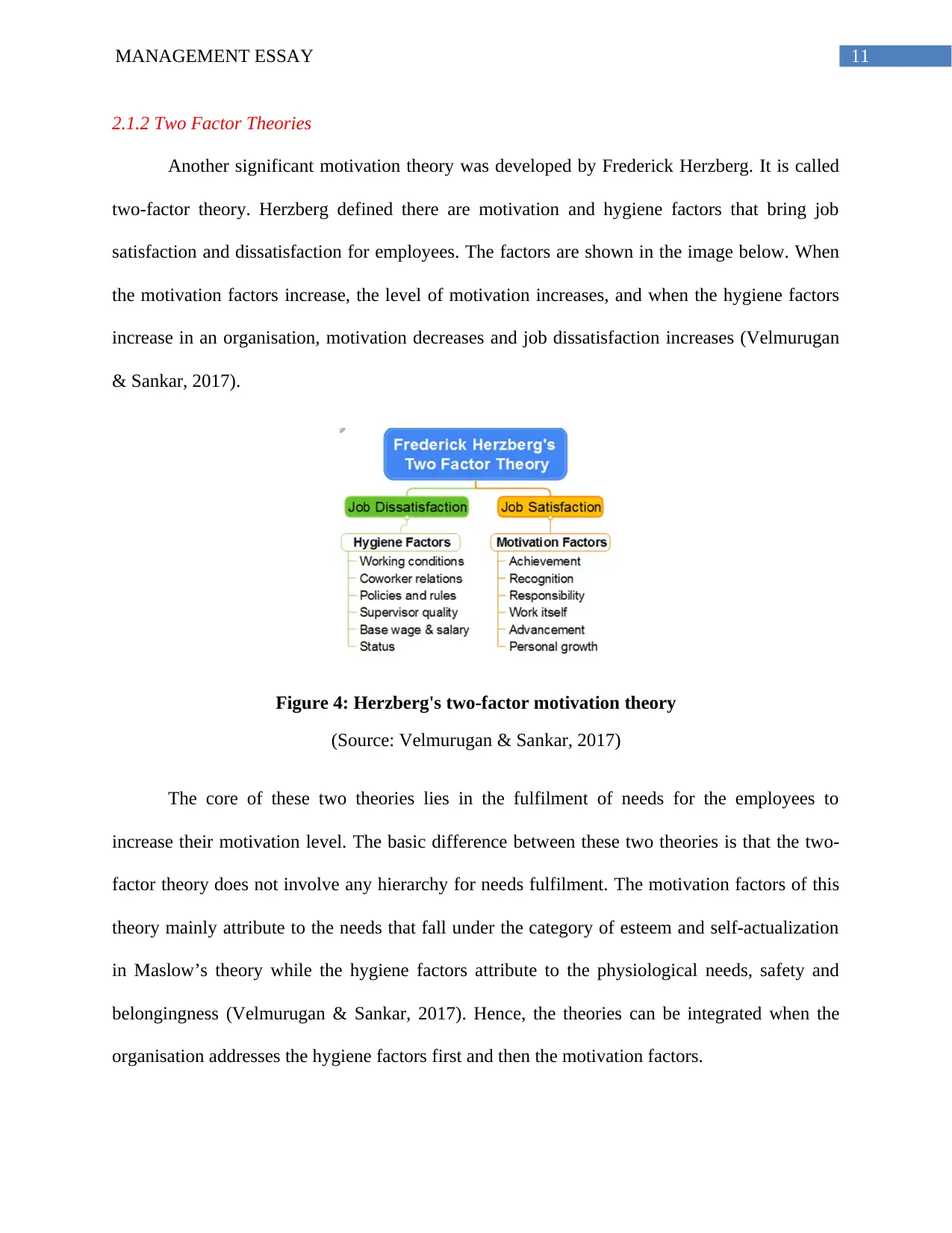
11MANAGEMENT ESSAY
2.1.2 Two Factor Theories
Another significant motivation theory was developed by Frederick Herzberg. It is called
two-factor theory. Herzberg defined there are motivation and hygiene factors that bring job
satisfaction and dissatisfaction for employees. The factors are shown in the image below. When
the motivation factors increase, the level of motivation increases, and when the hygiene factors
increase in an organisation, motivation decreases and job dissatisfaction increases (Velmurugan
& Sankar, 2017).
Figure 4: Herzberg's two-factor motivation theory
(Source: Velmurugan & Sankar, 2017)
The core of these two theories lies in the fulfilment of needs for the employees to
increase their motivation level. The basic difference between these two theories is that the two-
factor theory does not involve any hierarchy for needs fulfilment. The motivation factors of this
theory mainly attribute to the needs that fall under the category of esteem and self-actualization
in Maslow’s theory while the hygiene factors attribute to the physiological needs, safety and
belongingness (Velmurugan & Sankar, 2017). Hence, the theories can be integrated when the
organisation addresses the hygiene factors first and then the motivation factors.
2.1.2 Two Factor Theories
Another significant motivation theory was developed by Frederick Herzberg. It is called
two-factor theory. Herzberg defined there are motivation and hygiene factors that bring job
satisfaction and dissatisfaction for employees. The factors are shown in the image below. When
the motivation factors increase, the level of motivation increases, and when the hygiene factors
increase in an organisation, motivation decreases and job dissatisfaction increases (Velmurugan
& Sankar, 2017).
Figure 4: Herzberg's two-factor motivation theory
(Source: Velmurugan & Sankar, 2017)
The core of these two theories lies in the fulfilment of needs for the employees to
increase their motivation level. The basic difference between these two theories is that the two-
factor theory does not involve any hierarchy for needs fulfilment. The motivation factors of this
theory mainly attribute to the needs that fall under the category of esteem and self-actualization
in Maslow’s theory while the hygiene factors attribute to the physiological needs, safety and
belongingness (Velmurugan & Sankar, 2017). Hence, the theories can be integrated when the
organisation addresses the hygiene factors first and then the motivation factors.
⊘ This is a preview!⊘
Do you want full access?
Subscribe today to unlock all pages.

Trusted by 1+ million students worldwide
1 out of 23
Related Documents
Your All-in-One AI-Powered Toolkit for Academic Success.
+13062052269
info@desklib.com
Available 24*7 on WhatsApp / Email
![[object Object]](/_next/static/media/star-bottom.7253800d.svg)
Unlock your academic potential
Copyright © 2020–2025 A2Z Services. All Rights Reserved. Developed and managed by ZUCOL.





